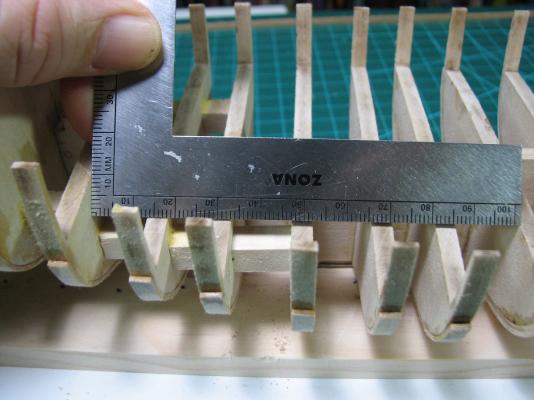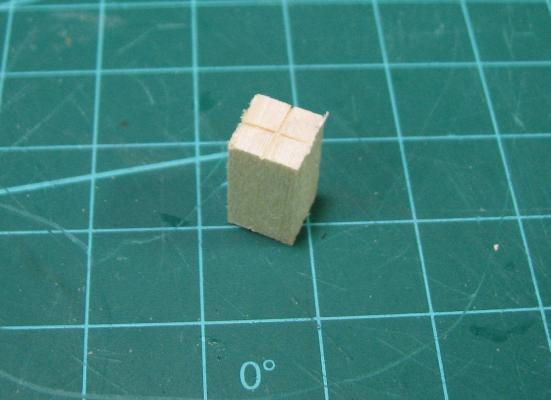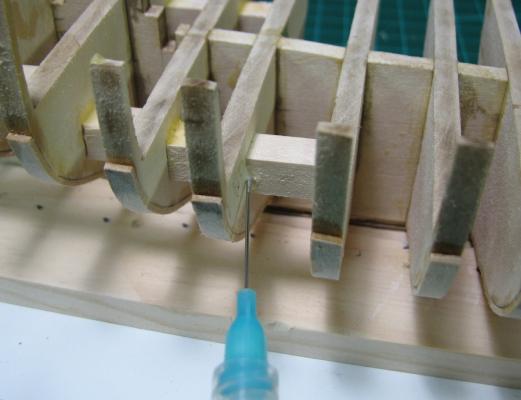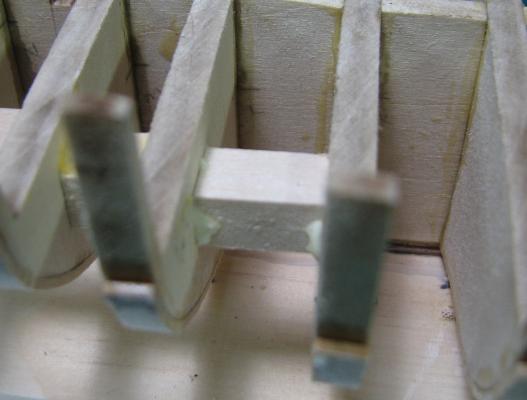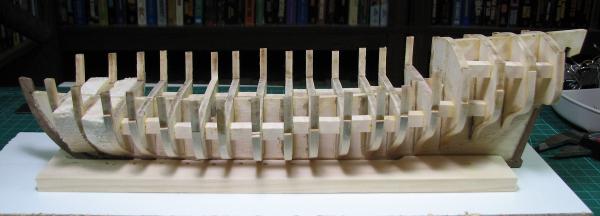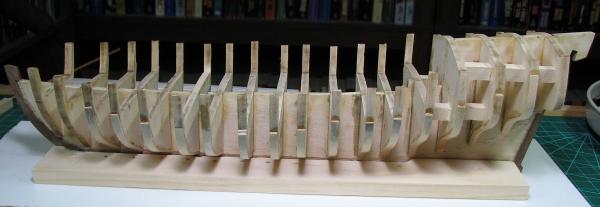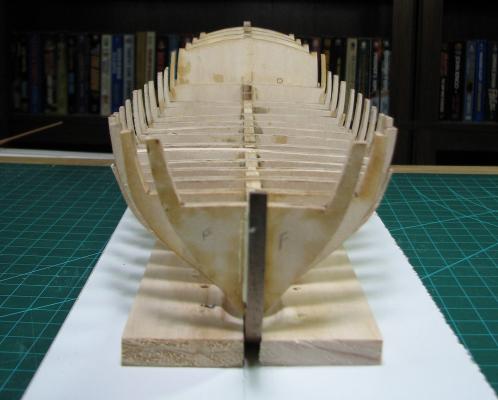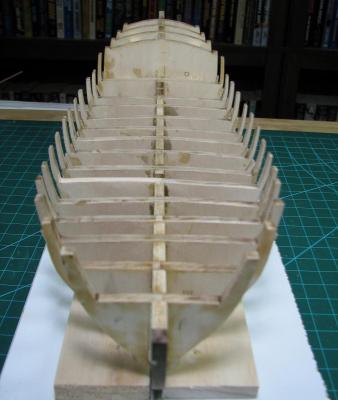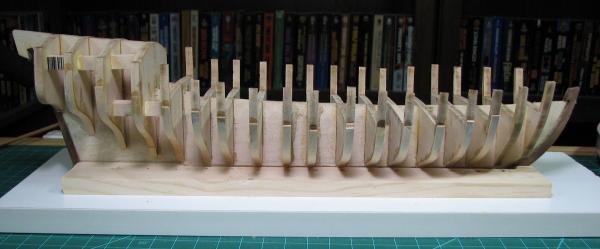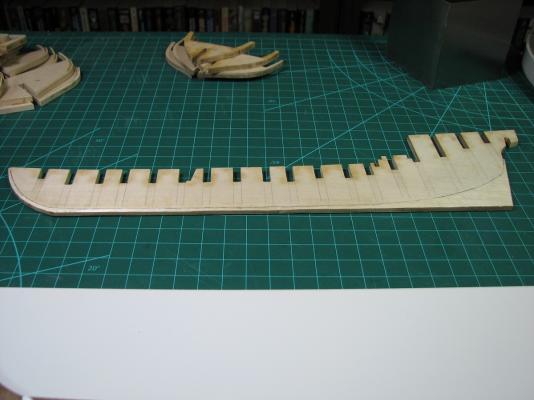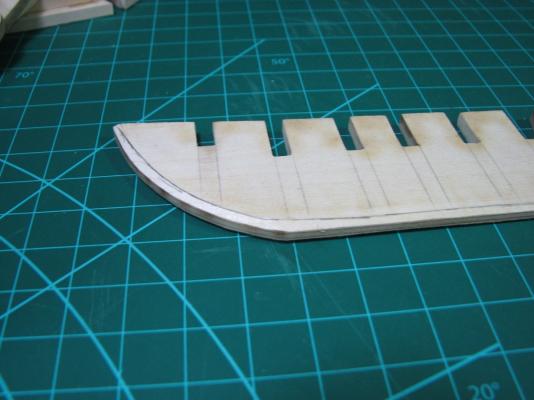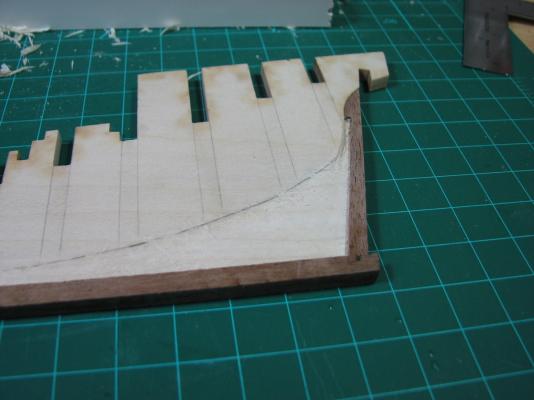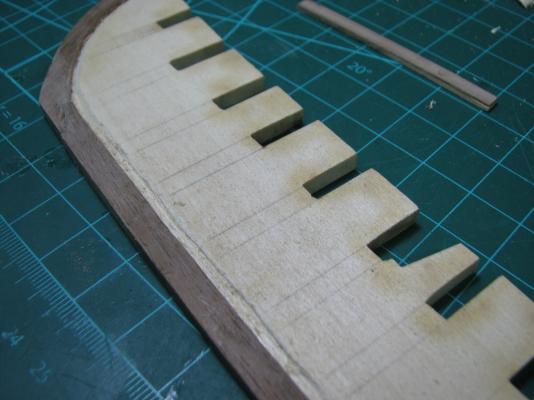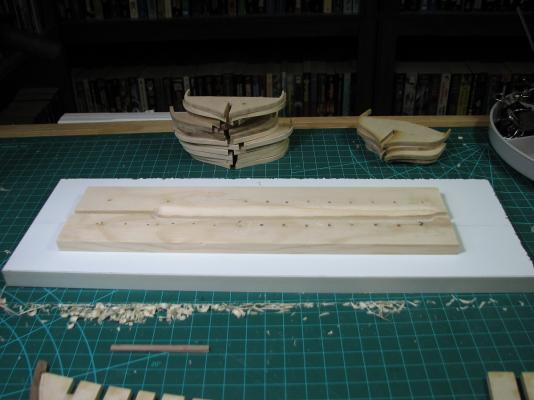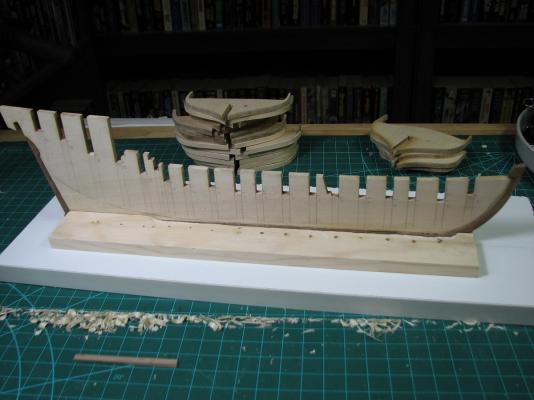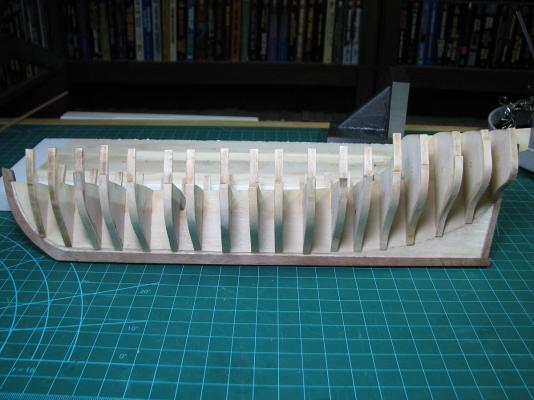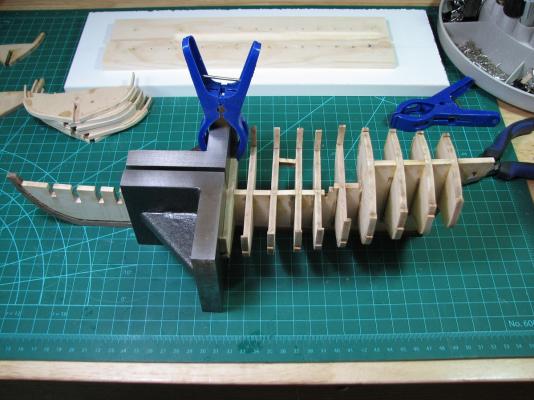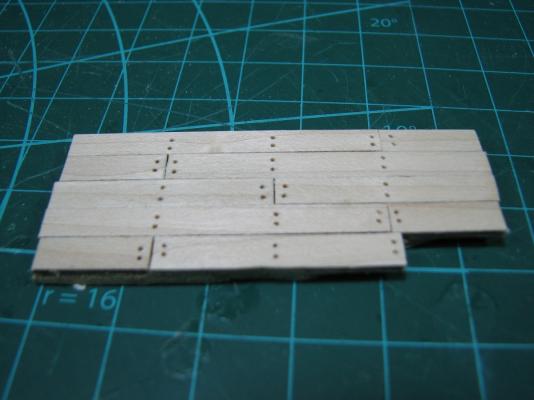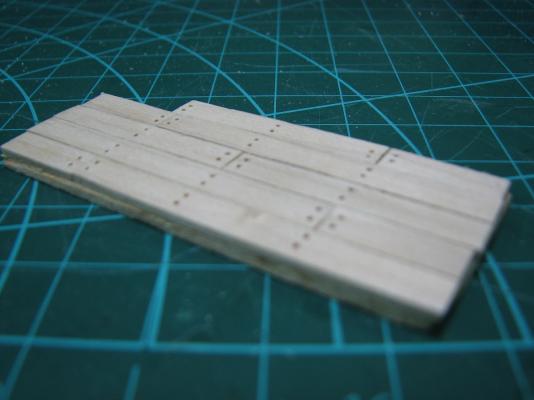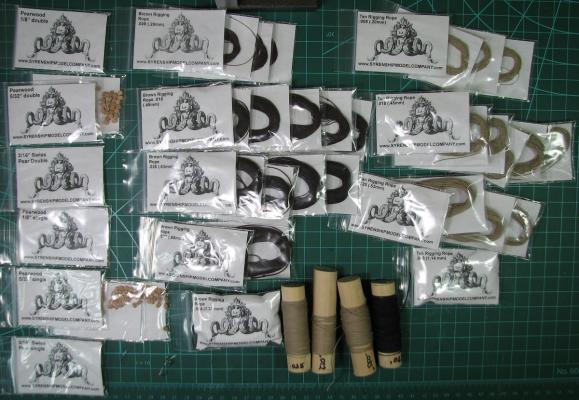-
Posts
2,213 -
Joined
-
Last visited
Content Type
Profiles
Forums
Gallery
Events
Everything posted by GuntherMT
-
Thanks Dragzz and Steve, Those are 'Angle Plates' from Micro Mark ( http://www.micromark.com/3-x-3-x-3-inch-angle-plate,7134.html ). This is the first time I've used them, and I'm not sold on their value vs. the cost. I did get them on sale so didn't spend full price, but they are still fairly pricey when I think that the Lego/Duplo block solutions I've seen would work just as well, at least for this part of the job. I don't have kids, so didn't have any of those blocks around to steal. On the other hand, they are heavy flat pieces of steel that can be used as weights and nice flat surfaces, and I didn't have anything like that before, so they will have other uses than just as a nice squaring tool.
- 831 replies
-
- Armed Virginia Sloop
- Model Shipways
-
(and 1 more)
Tagged with:
-
Nicely done. Congratulations on crossing the finish line with a beautiful model.
- 384 replies
-
- san francisco ii
- artesania latina
-
(and 1 more)
Tagged with:
-
Thank you Slog. I've finished the reinforcement blocks finally, although I chose to completely fill the final two gaps at the bow rather than use the blocks, in order to help me see the 'flow' of the hull up there when I get to fairing. While doing the reinforcement blocks, I used the opportunity to correct any minor out of square issues with the bulkheads. I did this by measuring at multiple points along the top of each bulkhead, always taking my measurements off of bulkhead 'O' which I took great care to square up with all the stern bulkheads and the keel. After measuring to determine if I needed any adjustments to the bulkheads, I would cut individual blocks and then fine tune them until they caused the measurements from bulkhead 'O' to be right where I wanted them, and equal on both sides. I was having some issues where the addition of the glue prior to final fitting would actually change my measurements slightly, so I devised a technique to apply the glue after fitting the blocks in place, so that I did not need to compensate for the glue thickness on the ends of the blocks. After my final measurements and test fitting was complete, I cut a 'cross' into both ends of the block with a razor saw. I would then slightly widen the leg of the cross that would be 'outboard', and then place the block without glue, and hold it in place (if needed) with needle nose pliers, while I used a syringe to inject the glue into the cross via the slightly wider leg. As can be seen here, the glue would flow through the cross, and would almost always bubble out of each of the other three points almost equally. This method seemed to work quite well, and I had no measurement changes between the final test fit, and the glued in blocks after starting this system. After the glue had set for a couple minutes I would then use the syringe to lay a 'bead' of glue around all four edges of the block where it laid against the bulkheads. Testing several blocks that were completely dried shows that they have plenty of strength with this system. After inserting the last two spaces with filler blocks, this is where I'm currently at. Every bulkhead is even with bulkhead 'O' along at least 3 points on each side, to less than 0.5mm now with all reinforcements in place. Next I'll begin to work on the sub-decks braces and sub-decks for fitment, and the bow fillers I think.
- 831 replies
-
- Armed Virginia Sloop
- Model Shipways
-
(and 1 more)
Tagged with:
-

HMB Endeavour by mikec - Eaglemoss
GuntherMT replied to mikec's topic in - Kit build logs for subjects built from 1751 - 1800
Those anchor rings look fantastic. Little details like that will add up to make the build really stand out I bet. -
Beautiful job on the ship's boats, and I love the scaling shots. They seemed much larger until those pictures.
-
Thanks Ken, and yes there is quite a bit of fairing to do before laying the deck. I plan to do that after all of the reinforcement blocks are placed.
- 831 replies
-
- Armed Virginia Sloop
- Model Shipways
-
(and 1 more)
Tagged with:
-
Thanks Rich, and I got your message and sent him an email. Alistair, thanks for the tip - I could probably use that same filler that messed up the Carmen hull so much, as it's very light colored (which was the problem with it in that scenario on walnut). I'll do some testing with that. Fairly brief update tonight, spent most of the day at a charity event so not much time on the ship. I finished gluing in all the bulkheads, and I have started placing reinforcing blocks between the bulkheads. I'm using 5/16" square basswood for the blocks. I was going to use balsa, but it's just as expensive as basswood, so I just got basswood figuring it will always be useful to have extra basswood bits around. After last nights update, I decided to do "one more bulkhead" before bed. Yea, I'm dumb that way. I managed to get distracted after gluing it in place and setting the blocks against it, and left it so long that the excess glue got onto the blocks and glued the bulkhead to both blocks. I broke both sides of the bulkhead trying to get them apart. Because the center slot was solid, and the breaks were both clean, I drilled a hole through the center of the now solid slot, drilled a hole into both sides and pinned the broken pieces all back together with a single long pin made from a toothpick. After the glue dried, I think it's the strongest bulkhead I have now.
- 831 replies
-
- Armed Virginia Sloop
- Model Shipways
-
(and 1 more)
Tagged with:
-
Rich, I bet that most people who see your beautiful model will have no idea about the grates unless you tell them! Send me the info for this new AZ Shipwrights group would you? The other thread got moved, so not sure anyone noticed the latest activity there. Thanks,
- 1,756 replies
-
- constitution
- constructo
-
(and 1 more)
Tagged with:
-
Thanks Ken. I am planning to place supporting blocks in between the bulkheads before I work on sanding the tops of the bulkheads for the sub-deck placement, which will be done before I work on the fairing for the planking. I want to make the structure as rigid as possible for that work so my ham-fists don't break more bulkheads, hopefully.
- 831 replies
-
- Armed Virginia Sloop
- Model Shipways
-
(and 1 more)
Tagged with:
-
Hi Frank! I guess that the MS kits have issues with bulkhead alignments. Oh well, I guess they have to make it a challenge somehow, other than including the worst rigging line in the history of the universe. Some photos to catch up with my text. Work on pre-cutting the rabbet prior to installing the keel. Installed the keel, stem, and sternpost. The stem had to be done twice since it shifted when I left it to dry overnight. The sternpost required that the slot in the keel be re-made, as it was out of position. I've read that this seems to be a common issue with the kit. Took some sanding to get the sternpost to fit decently. After the keel was dried for a while, I finished the rabbet. I did this using a suggested method of using a piece of planking made up with both the basswood inner, and walnut outer plank stuck together for sizing. Doing this I think I have a larger rabbet than is indicated anywhere in order to make it fit right. Guess I'll find out later how it works out. Jpett started a thread yesterday in Wood Tips reminding me that I needed to make a build board, so I chopped up a piece of MDF shelf, and made a thing. Finished attaching all of the shims to the bottom of the bulkheads. After some thought I decided not to extend the shims all the way up the extensions, as I think that will make fairing more difficult, as I won't have a baseline of the extensions to work from. And then, I began fitting bulkheads. Started at the rear, let each bulkhead dry for 30 minutes or so (using Titebond wood glue - it sets up pretty solid in 30 minutes). While I was waiting on the bulkheads to dry, I chopped up a piece of maple strip and made a test decking bit to see how maple might look like if I can't get Holly in a timely manner. I need to work on my planking techniques before I get to the real thing. Not sure what to use for the nail holes (i.e. what to fill them with) at this point. Apparently I also need to work on getting the subject matter into the focused area of the shot! Plugging away at the bulkhead mounting, hope to have them all finished tomorrow.
- 831 replies
-
- Armed Virginia Sloop
- Model Shipways
-
(and 1 more)
Tagged with:
-
Hey Brett, you just made me smack my forehead, as the way you thought I was doing it might have actually made more sense than the way I actually did it. I shimmed the bottom of every bulkhead, not the top. I had a couple of bulkheads that also needed to be shimmed up to the deck level. I've finished the rabbet already. I did it the way Bob Hunt shows in his chapter 1 pdf, I cut it down about halfway, then glued on the keel (which I had to redo because the stem 'slipped' somehow after I set it up to dry), and then after the keel was on, I finished the rabbet. I think I may have cut it too deep, as I was doing it by test fitting a section of planking (both layers), and to get it to fit like the illustration shows, took it pretty deep. This will be fine once it's got the actual planking on it for strength, but right now I'm treading lightly on anything related to the keel. I also managed to break a bulkhead (bulkhead "L") at the keel notch. I clued it and clamped it in place a few hours ago. Since it broke right at the edge of the keel, and not all the way through, I think it should be fine, as it will not only be glued to the bulkhead where it broke, but the length of the notch where it fits over the keel as well. Again, once it's reinforced it should be solid. ------------- Alistair - yea, I've sort of come to that realization, especially when it comes to the rigging line, as the stuff in both the Constructo and the MS kits are complete garbage (in very different ways). I may end up doing a ropewalk if I keep this up, but I'll need to research thread sources and how to figure out how to size it and everything else if I go that route down the road. --------------- Tony - thanks for dropping in. I'm single with no significant other, and apparently way too much free time on my hands and I don't watch TV. This allows me to spend far too much time with whatever my current hobby of choice is. I don't think I'm working all that fast (at least not on the AVS, I certainly rushed the Carmen in retrospect), it's simply that I have plenty of time to spend on this. The bulkhead shimming, cutting the rabbet, gluing the keel, and now mounting the first 7 bulkheads has been a pretty significant time investment (no actual values, I don't keep a log), but I'm able to drop 4-6 hours an evening, and as much time as I want on the weekends, so I can move forward more easily than someone with a family and other responsibilities in their life who must spread that same amount of hobby time over 4 or 5 times as many days as I do.
- 831 replies
-
- Armed Virginia Sloop
- Model Shipways
-
(and 1 more)
Tagged with:
-
Thanks for dropping in Paul, and for the kind words. In retrospect, I think I got incredibly lucky with the Carmen, as when I first started I knew nothing about how to square up the bulkheads and properly fair the hull. The fact that my complete lack of doing any of the right things at that point in the build never came back to really bite me and wreck the entire effort can be attributed purely to dumb luck I believe. A ship with the complexity of the Endeavour is still a number of builds off for me I believe. I'm not sure I have the patience to take on a build that I know in advance would take me a year or more. I have an idea of what my next couple of builds might be, but for now I'm just going to concentrate on doing the AVS the correct way, and learn the proper methods of doing things to be applied going forward. Best of luck on Endeavour, I'll be looking for it!
- 119 replies
-
- carmen
- constructo
-
(and 2 more)
Tagged with:
-
If this one isn't "worthy" of going in the gallery, then I fear nothing I ever build will meet the criteria of being "worthy". Your Sovereign of the Seas is incredible, and someday I hope to have put together a model that is even close to as nice looking. So yea, you can put me in the 'You should put this in the gallery - with lots of photos' column.
- 555 replies
-
- sovereign of the seas
- mantua
-
(and 1 more)
Tagged with:
-
She's looking great Brett. Hopefully when I get that far my planking will be good looking enough that I have a hard choice as to whether or not to paint!
- 129 replies
-
- armed virginia sloop
- model shipways
-
(and 1 more)
Tagged with:
-
So I do believe that you lot of scallywags in this community have completely warped my concept of what exactly a "kit" for building a model is...
- 831 replies
-
- Armed Virginia Sloop
- Model Shipways
-
(and 1 more)
Tagged with:
-
Very nice. I think there are as many lines on your bowsprit, as my first build (the Carmen) had altogether.
- 319 replies
-
As long as it's the original Tite Bond, water should work. Depending on how long it's been glued you may have to let it soak for a while. If you can get a wet rag or gauze or something up against the connection you want to de-bond, and keep it wet for a while, it should free up after a while. If it's Tite Bond II (I think) which is waterproof.. well, then I don't know.
About us
Modelshipworld - Advancing Ship Modeling through Research
SSL Secured
Your security is important for us so this Website is SSL-Secured
NRG Mailing Address
Nautical Research Guild
237 South Lincoln Street
Westmont IL, 60559-1917
Model Ship World ® and the MSW logo are Registered Trademarks, and belong to the Nautical Research Guild (United States Patent and Trademark Office: No. 6,929,264 & No. 6,929,274, registered Dec. 20, 2022)
Helpful Links
About the NRG
If you enjoy building ship models that are historically accurate as well as beautiful, then The Nautical Research Guild (NRG) is just right for you.
The Guild is a non-profit educational organization whose mission is to “Advance Ship Modeling Through Research”. We provide support to our members in their efforts to raise the quality of their model ships.
The Nautical Research Guild has published our world-renowned quarterly magazine, The Nautical Research Journal, since 1955. The pages of the Journal are full of articles by accomplished ship modelers who show you how they create those exquisite details on their models, and by maritime historians who show you the correct details to build. The Journal is available in both print and digital editions. Go to the NRG web site (www.thenrg.org) to download a complimentary digital copy of the Journal. The NRG also publishes plan sets, books and compilations of back issues of the Journal and the former Ships in Scale and Model Ship Builder magazines.



